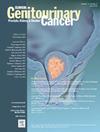Sodium-Glucose Cotransporter 2 (SGLT2) as a Potential Biomarker and Target in Papillary Renal Cell Carcinoma
IF 2.3
3区 医学
Q3 ONCOLOGY
引用次数: 0
Abstract
Background
SGLT2 is selectively expressed in the human kidney. SGLT2 inhibitors have markedly changed diabetes, heart failure, and kidney disease treatment, and are under investigation in cancer. However, the role of SGLT2 in papillary renal cell carcinoma (pRCC) is not known.
Methods
We investigated the SGLT2 gene expression, associated clinical-molecular features, and overall survival (OS) in pRCC. The Cancer Genome Atlas Program and Gene Expression Omnibus data were utilized. mRNA expression z-scores of the SGLT2 gene relative to normal samples (log-RNASeqV2-RSEM, threshold ± 2) were analyzed (low, unaltered, high expression).
Results
273 patients were involved. As per mRNA expression, 180 patients (66%) had low, and the remaining had unaltered expression. High correlation (r > 0.6) with SGLT2 was observed in IRX5, STRIP2, LINC00899, SATB2-AS1, FOXC1, IRX3, SLC22A8, SH3BP5 genes (P < .001,q < 0.001 for all) and with the HIF-2α (r:0.43, P < .001,q < 0.001). Tumor mutational burden (P = .365) and aneuploidy scores (P = .976) did not differ, however, among the genes with the highest alteration frequency, SETD2 alterations (15.63% vs. 1.07%, P < .00, q = 0.046) were more frequent in the unaltered-expression group. Differential protein expression analysis showed highly separated proteins (ERBB2, AR, MAPK14, VHL, TGM2 in the low and SHC1, SQSTM1, MYH14, and CDH1 in the unaltered group). The median OS has not reached the median in both groups [Hazard Ratio(HR) for the unaltered group:2.658, 95% Confidence Interval(CI):1.401-5.043, P = .003]. SGLT2 expression remained a significant prognostic factor in multivariable analysis [HR:2.446 (95%CI: 1.199-4.990), P = .014].
Conclusions
This study reveals the first data that SGLT2 might have a role in pRCC as a pathogenic factor and biomarker. Confirmatory mechanistic studies are needed.
钠-葡萄糖共转运蛋白2 (SGLT2)作为乳头状肾细胞癌的潜在生物标志物和靶点
dsglt2在人肾脏中选择性表达。SGLT2抑制剂已经显著改变了糖尿病、心力衰竭和肾脏疾病的治疗,并且正在对癌症进行研究。然而,SGLT2在乳头状肾细胞癌(pRCC)中的作用尚不清楚。方法研究SGLT2基因在pRCC中的表达、相关临床分子特征和总生存期(OS)。利用癌症基因组图谱程序和基因表达Omnibus数据。分析SGLT2基因相对于正常样本的mRNA表达z-score (log-RNASeqV2-RSEM,阈值±2)(低、不变、高表达)。结果共纳入273例患者。mRNA表达量方面,180例(66%)患者表达低,其余患者表达不变。高相关性(r >;在IRX5、STRIP2、LINC00899、SATB2-AS1、FOXC1、IRX3、SLC22A8、SH3BP5基因(P <;措施,q & lt;0.001)和HIF-2α (r:0.43, P <;措施,q & lt;0.001)。肿瘤突变负担(P = .365)和非整倍性评分(P = .976)没有差异,但在改变频率最高的基因中,SETD2改变(15.63%对1.07%,P <;.00, q = 0.046)在未改变表达组更常见。差异蛋白表达分析显示高度分离的蛋白(低水平组的ERBB2、AR、MAPK14、VHL、TGM2和未改变组的SHC1、SQSTM1、MYH14和CDH1)。两组的中位OS均未达到中位数[未改变组的风险比(HR):2.658, 95%可信区间(CI):1.401-5.043, P = 0.003]。在多变量分析中,SGLT2表达仍然是一个重要的预后因素[HR:2.446 (95%CI: 1.199-4.990), P = 0.014]。结论本研究首次发现SGLT2可能在pRCC中作为致病因子和生物标志物发挥作用。还需要进一步的机理研究。
本文章由计算机程序翻译,如有差异,请以英文原文为准。
求助全文
约1分钟内获得全文
求助全文
来源期刊

Clinical genitourinary cancer
医学-泌尿学与肾脏学
CiteScore
5.20
自引率
6.20%
发文量
201
审稿时长
54 days
期刊介绍:
Clinical Genitourinary Cancer is a peer-reviewed journal that publishes original articles describing various aspects of clinical and translational research in genitourinary cancers. Clinical Genitourinary Cancer is devoted to articles on detection, diagnosis, prevention, and treatment of genitourinary cancers. The main emphasis is on recent scientific developments in all areas related to genitourinary malignancies. Specific areas of interest include clinical research and mechanistic approaches; drug sensitivity and resistance; gene and antisense therapy; pathology, markers, and prognostic indicators; chemoprevention strategies; multimodality therapy; and integration of various approaches.
 求助内容:
求助内容: 应助结果提醒方式:
应助结果提醒方式:


